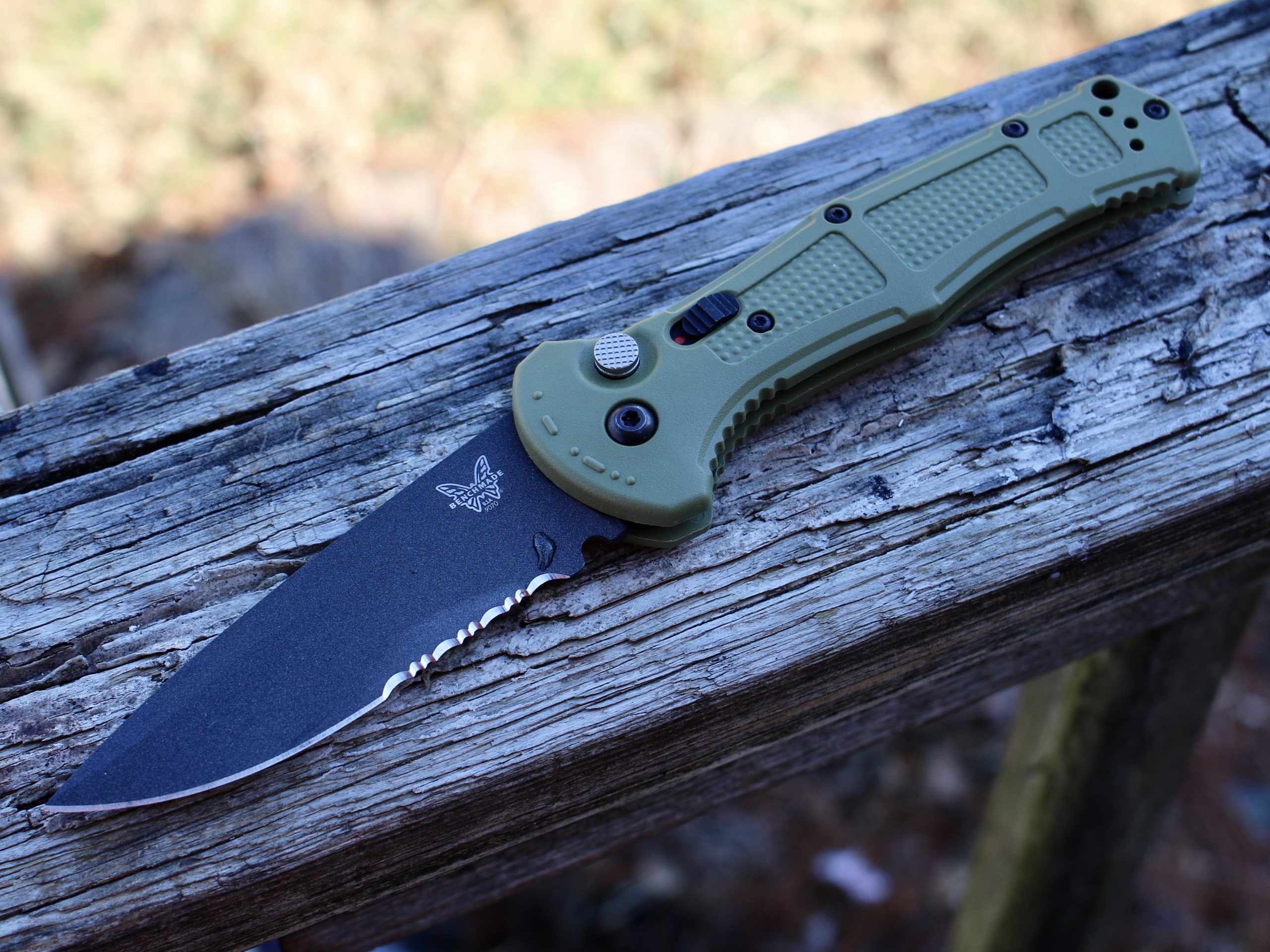The Benchmade Claymore is a deceptive tool. While it looks like some of the other Benchmades, this automatic knife is built to bring a high level of performance and strength in a package that is still subtle enough to carry in a pocket on a pair of slacks. This is fast becoming my favorite go-to for EDC, and would be a solid choice for a go-bag, too.
The Claymore, like its namesake, is built tough enough for war.

Claymore Specifications
- Blade Length: 3.60″ | 8.64cm
- Blade Thickness: 0.114″ | 2.896mm
- Open Length: 8.60″ | 19.81cm
- Closed Length: 5.00″ | 11.18cm
- Handle Thickness: 0.60″ | 14.99mm
- Weight: 3.50oz | 97.24g
I’ll highlight a couple of these. The blade length isn’t gratuitous. At just over three-and-a-half inches, this is hardly a fighting knife designed to perforate internal organs. Still, it is a capable design for self defense.
The second is the weight. 3.5 ounces. That’s nothing. Yet Benchmade notes that this design has proven to be their most robust folder—it held more weight before breaking than any other Benchmade design.

Features
- Blade Edge: Serrated
- Blade Finish/Color: Cobalt Black
- Blade Steel: CPM-D2 (60-62 HRC)
- Blade Style/Shape: Drop-point
- Clip Type: Deep-Carry
- Clip Position: Reversible Tip-Up
- Handle Material: Grivory
The Claymore’s frame, which only extends through part of the grip, is steel. Like other Benchmades, it is a minimalist design that works surprisingly well. This is what keeps the weight down. The Grivory is a very hard plastic, and has a plastic feel, but that’s something you’ll need to live with for the weight/strength ratio.

If you read Morse Code, the Grivory FTE will point you toward the homage. As I will explain later, the Front Toward Enemy advice is sound.
But let’s get back to the crux of this design—the CPM-D2 blade that scores a Rockwell 60-62 score for hardness. That’s important. This blade is thin, and most American knives stay lower on the Rockwell scale—closer to 56-58. The increase in hardness means the blade will hold its edge better, and longer. It also means it will be moderately more complicated to resharpen. And it can equate to brittleness.
This blade (and I’ve been testing it regularly for more than 6 months now) has not broken, chipped, or dulled. It is holding up superbly and makes a compelling argument for harder steel used in such designs.
Automatic Knives
They Claymore is an auto. It would be what we colloquially call a switchblade. Inside the covers there’s a coiled spring that flat-out launches the blade out when you push the button.
The Claymore has a safety, too, which is useful—and should be used—as I found out.

Note, first, the picture below. If you carry this in your pocket, with the clip facing out, the button (at least in the right hand orientation) faces in. Any impact on the knife itself will compress it into your leg, and won’t deploy the blade. And if it did—like if there was pocket change or something that hit the button, the blade would open out, and not toward—well—vital organs.

I was working on a review with my laptop on my lap when my cat went for a bird that had landed in a near-by window sill. The cat hit the glass, scared itself stupid, and then ran back across me—claws out. I dropped my Mac, scrambled to catch it, and the corner of the laptop landed precisely on the button of the Claymore which I had in my pocket (but not secured with the pocket clip).
In the confusion, and worried about catching the laptop that I’d half-way thrown, I didn’t notice that the knife had opened. The blade simply snapped into my pocket and I was none-the-wiser.
Until I stuck my hand in my pocket, later.

This was a bad one. My thumb ran over the serrated portion of the blade and the cut, which more than half-an-inch into my thumb (and would have gone farther had it not been for my thumbnail arresting the momentum).
The next moments seem oddly comical now. I ran around the house, dripping blood everywhere, looking for my wife who I found taking a nap. It wasn’t how she wanted to be woken up. And the cut was a bit of a bitch to close up—super clean cuts often are—and we were trying to use butterfly closures on a cut that should really have been sewn up.
The Practical Side of the Claymore
Twenty years ago, I had a good friend who was an ER nurse. He was the first person I’d known who carried a Benchmade. He was also a very skilled woodworker and understood blade angles, steel composition, and how to keep tools sharp. His Benchmade, he said—as a tool—was worth every penny.

At the time, I couldn’t afford one. And I can see how the $230 MSRP on the Claymore might be an obstacle for many. While I don’t put any stock in fashion, and can’t stand paying prices based on brand names, I will say that this is a price I can defend. From the intracacies of the lock mechanism to the quality of the steel, the Claymore delivers.

You will need to keep things clean. The button that deploys the blade is also the lock. Pocket lint and dirt will impede function.
There’s no difficulty or nuance needed for cleaning, though. Simply run it under a sink, or brush out larger obstructions. Oil occasionally–though do so lightly and with a thin oil.

The knife—even the lock—is built from corrosion-resistant materials. The Grivory may get chewed up a bit with regular use. The blade has a Cerakote finish that may—eventually—show wear. The other metal pins and bolts are all finshed, too, in coating designed to keep rust at bay.

How to sharpen the Claymore?
How often will you need to sharpen this knife depends, of course, on how you use it. The CPM-D2 is a powder deposition steel and has a low chromium content. It will pose a challenge to a novice sharpener.

The flat secondary edge will be easy enough to work, though. The serrations are a different story. I would avoid cutting with that part of the blade to prolong the life for when the aggressive nature of the serrations is needed most.
And a note on serrations. The reason why there are high points is to keep the cutting edge from contacting the harder, abrasive surfaces (like plates or cutting boards). Consider cutting an onion. The teeth ride on the cutting board and the protected edge inside the arc does what it does best—it cuts.
On the Claymore, the teeth are more useful for the emergency needs of cutting a seat-belt or cutting ropes.

Final Thoughts
The Claymore is an accomplishment of engineering and design. While it isn’t a knife that strikes me at first glance as an aesthetic masterpiece, I’ve come to love every aspect of the knife. This is one that I’ll inevitably have several of.

If your local laws allow you to carry an auto, this is my recommendation.


